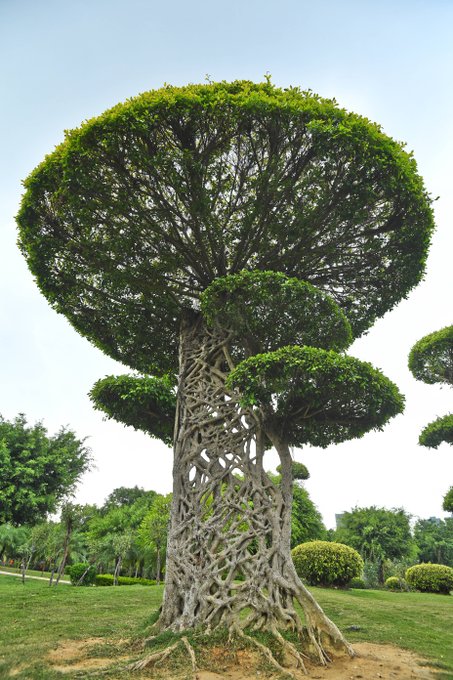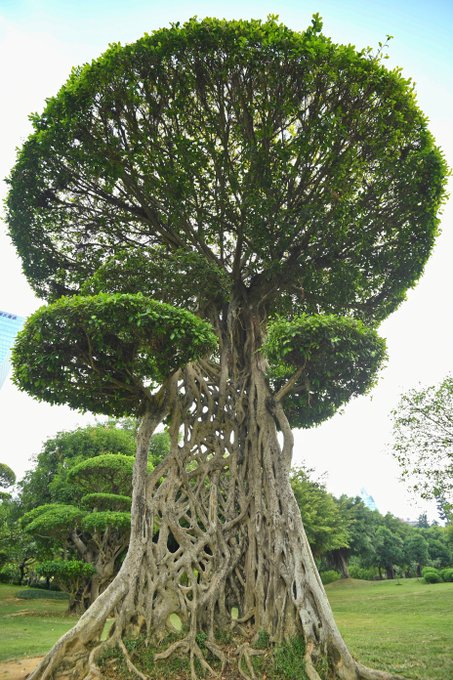Most Amazing Trees In The World

May 16, 2023
•10 min read
There are loads of unique and unusual trees! Let's explore some of the coolest trees ever discovered!
What would we really do without trees? They provide us with oxygen, food, medicine, habitat for animals, and prevent soil erosion. While all trees are nothing short of spectacular, some really stand out. Let's explore some of the coolest trees in the world you’ve probably never heard of.
Rainbow Eucalyptus
This next tree looks like a work of art and its colorful patterns are a result of sections of bark shedding at different times during the year. It starts off a light brown and then a light green which over time turns into hues of dark green, blue, pink, red, purple, orange and every other color of the rainbow.
This isn’t the only thing that’s very interesting about this tree. The rainbow eucalyptus is the only eucalyptus tree that lives in rainforests, indigenous to the Philippines, Indonesia and Papua New Guinea. It is also one of the fastest growing trees at over 3 feet per year and its trunk can get quite large, up to a diameter of 6 feet.Hyperion, The World's Tallest Tree
If you were at a tree concert, you wouldn’t want to be standing behind this guy. The Hyperion is a coast redwood in California that is 115 meters, or 380 feet tall, making it the world’s tallest living tree.
It was found in a remote area of Redwood National and State Parks in August 2006. It’s estimated to be at least 600 years old though some reports say it’s about 700-800 years old. If you can’t picture just how tall the Hyperion is, just imagine it’s about 75 feet taller than the Statue of Liberty and about 63 feet taller than Big Ben.
Dragon’s Blood Tree
This tree is native to a remote island two hundred miles off the coast of Yemen called Socotra. Its unique umbrella shape is distinctive and it gets its name based on its bright red sap. The sap is used as a dye and was used as a violin varnish and as a folk remedy for various ailments.
Dragon’s blood trees can live to be thousands of years old and take a long time to mature before they reproduce. Unfortunately, these trees are becoming endangered as several of them were uprooted when the island was hit by numerous cyclones since 2015.Web Trees
A remarkable fig tree in Nanning, in the Guangxi province of China, looks like a web of roots. They’re known for their extensive roots around the world. These strangler trees grow around objects and even wrap around other live trees, sucking the nutrients out of their roots and causing the original tree to die.
A most bizarre #tree has caught the eyes of passersby in Nanning, S China’s Guangxi, thanks to its incredible multiple branches and twigs tangling with each other.
Quaking Aspens
You might also think these trees are on the list because of their stunning canary-colored foliage but their true beauty lies below the surface, literally.
Above the ground, these trees seem to stand individually but actually, they’re joined together by their roots which can form one large organism that can expand up to 20 acres wide. The quaking aspen in Bryce Canyon National Park is estimated to be 80,000 years old! Now this is a specimen that proves there is strength in unity.Boab Prison Tree
Baobab trees grow in low-lying areas in Africa and Australia. They’re unique to other trees as their trunks can grow very large and their bark is smooth and shiny.
Because of their shape, they’re also known as “bottle trees” and are excellent for storing water during droughts. Their strange looks have always attracted sightseers but the particular tree below in Western Australia probably draws more than others.Trees of Life
This next tree seems to defy the boundaries of life and death. Known also as the “Tree Root Cave” or the “Kalaloch Tree”, this freak of nature is located just north of the Kalaloch Lodge in Washington.
It is from the largest family of spruce, the Sitka Spruce, and is noted for its height and wide trunk. But while erosion and other elements should have taken its life, this tree continues to thrive with its roots exposed and holding onto nothing but air. But what about a tree thriving in a desert? The Sharajat-al-Hayat or Tree of Life in Bahrain stands alone in an extremely harsh environment and has been doing so for over 400 years. Even though it is known for holding a great deal of water, you can’t help but wonder from where since there is no water source in sight.The Divi-Divi Tree
This tree is one of the largest of its kind ever found, at around 50 feet, or 15 meters tall. Formally known as Libidibiacoriaria, this tree looks contorted because its constantly hit by trade winds that batter the coastal sites where it often grows.
That means it’s a natural compass, and always points southwest. It’s a landmark of the countryside on island nations like Aruba, where the above picture was taken. When allowed to grow in regions without the wind, it looks like a normal tree.Chapel Oak
While some people might turn to the church for answers about the Trees of Life, what about if the tree itself is a church? Le Chene Chapelle or the Chapel Oak in the small village of Allouville-Bellefoss, France, houses not one but two small chapels. It is said to have been growing a thousand years ago which would make it one of the world’s oldest trees.
In the 1600s, the tree was struck by lightning which caused it to burn right through the center and this created a hollowed-out trunk. It miraculously survived and the local Abbot Du Detroit and Father Du Cerceau decided to build a shrine to the Virgin Mary in the hollow of the tree. Another small chapel and a staircase were later added. During the French Revolution, a mob threatened to burn down the Chapel Oak as it became a symbol of the old way but a local quickly renamed it to the Temple of Reason and it was spared.Circus Trees Of Gilroy Gardens
When Swede Axel Erlandson settled in California, he observed the process of inosculation, which is when one tree bonds to another. He then decided to create his own set of odd trees. It took him many years to shape, graft and prune these trees.
Arbol del Tule
The fame of this next tree spreads far and very, very wide. El Arbol del Tule or “Tree of Tule” is a formidable Montezuma cypress located in the town center of Santa Maria del Tule in Oaxaca, Mexico.
With a diameter of 11.62 meters, it’s considered the widest tree in the world. It is so wide that it was once assumed to be a merger of several trees but modern DNA analysis has proven that the Tree of Tule is actually just one individual tree. Estimated to be about 1,500 years old, it is also one of the world’s oldest trees. It is said it would take about 30 people with arms outstretched to join hands and encircle it, given that the heavily buttressed circumference ranges somewhere between 137 to 170 feet.Lone Cypress
This iconic Monterey cypress grows alone on a granite cliff overlooking California’s beautiful Pacific Coast.
The 250-year-old tree attracted many visitors and the owner of the Pebble Beach Golf Links and Resort registered a drawing of the tree as the company trademark in 1919. The tree has survived many harsh weather conditions including storms and droughts but a storm in February 2019 broke off one of its branches.149-Year-Old Wisteria
This Wisteria plant located in Ashikaga Flower in Japan may not be the largest in the world but it still covers an impressive 21,000 square feet, around 2,000 square meters. It can be traced back as early as 1870. While wisterias might look like trees, they are actually vines.
What makes this wisteria attract so many visitors is its glorious beauty! It looks like a magnificent late evening sky with splashes of pink and purple, truly a stunning sight. The vines tend to get very heavy so the structure is held up on steel supports which allow visitors to walk below its canopy and truly take in its beauty.Japanese Maple
This might be one of the most elegant trees you will ever see. The Japanese maple is a species of woody plant native to Japan, North Korea, South Korea, eastern Mongolia and southeast Russia. It is one of the most versatile small trees. Its twisting branches and variegated leaves of green, yellow and red makes this iconic tree look beautiful in any season.
Image data not availableAntarctic Beech
The Antarctic beech, or Ñire, is native to Argentina, Chile and the eastern highlands of Australia. These spectacular trees can be extremely old. Ancient specimens can be about 12,000 years old, meaning they’ve been around during the ice age!
What makes the particular beech below in Oregon spectacular is something that would usually not be so desirable: moss. This tree is fully draped by hanging moss but it gives it an eerie and almost enchanting beauty.Antarctic Beech Draped In Hanging Moss In Oregon boredpanda.com/most-beautiful…
Bonsai Tree
Last but certainly not least, or maybe it is the least in terms of size, is the Bonsai tree. Well, bonsai is not exactly a tree but an art form. And no, I am not being philosophical. Bonsai trees are normal plants that have been trained using sophisticated techniques such as regular pruning and wiring to keep them in miniature size and yet preserve the aesthetic qualities of the plant.
The term Bonsai simply means “planted in a container”. There are a number of amazing bonsai trees that are very extraordinary and worthy of mention. Look at this popular one in Shunkaen. It is known to be 800 years old! It takes a lot of patience to sculpt these trees but it seems worth the work. If you were amazed at the coolest trees in the world, you might want to read our article about the most dangerous trees you should never touch. Thanks for reading!



































